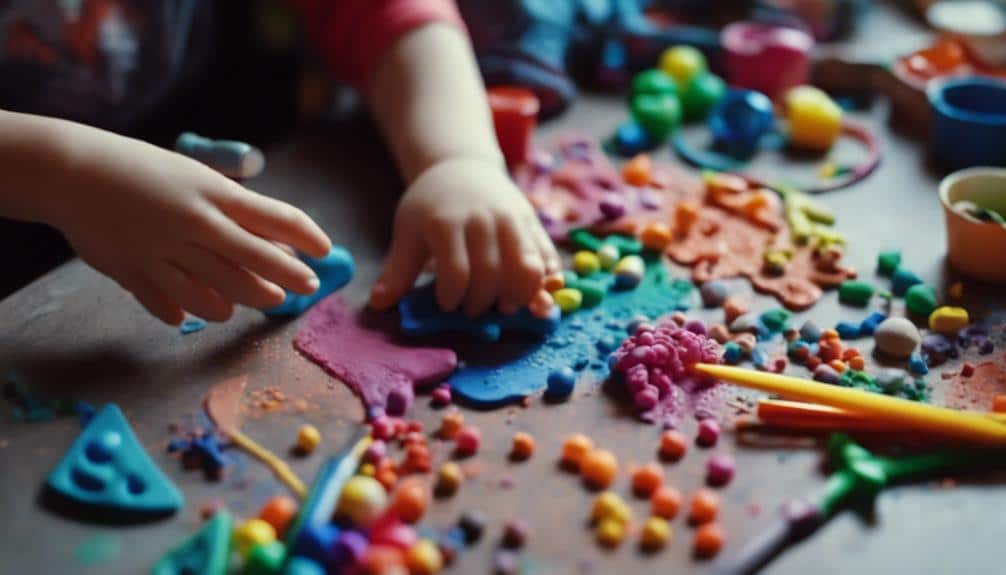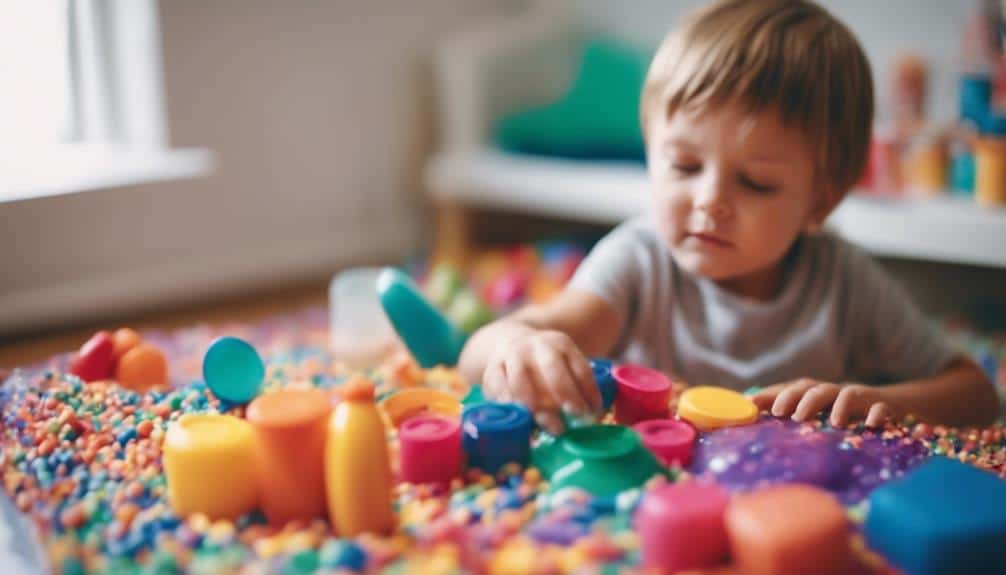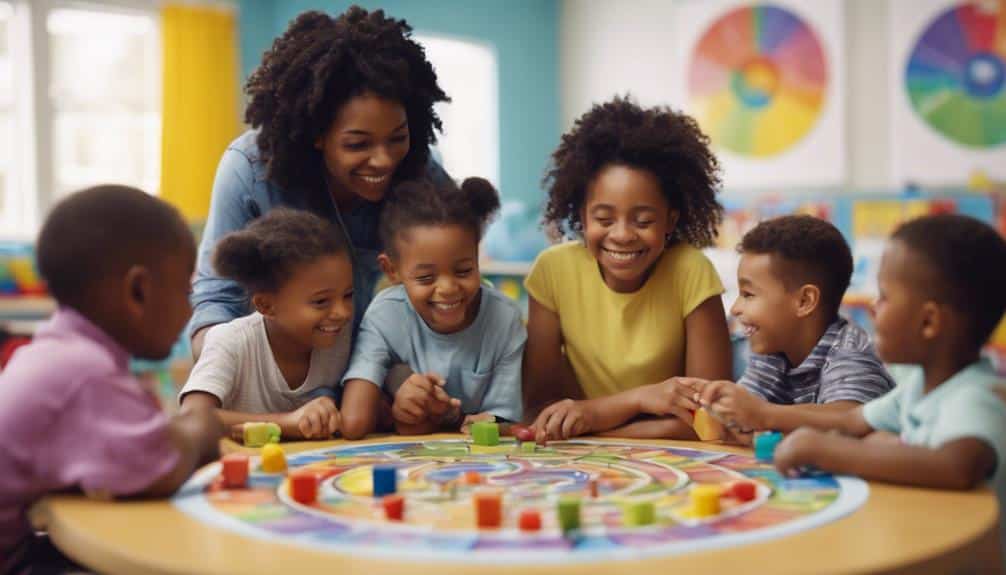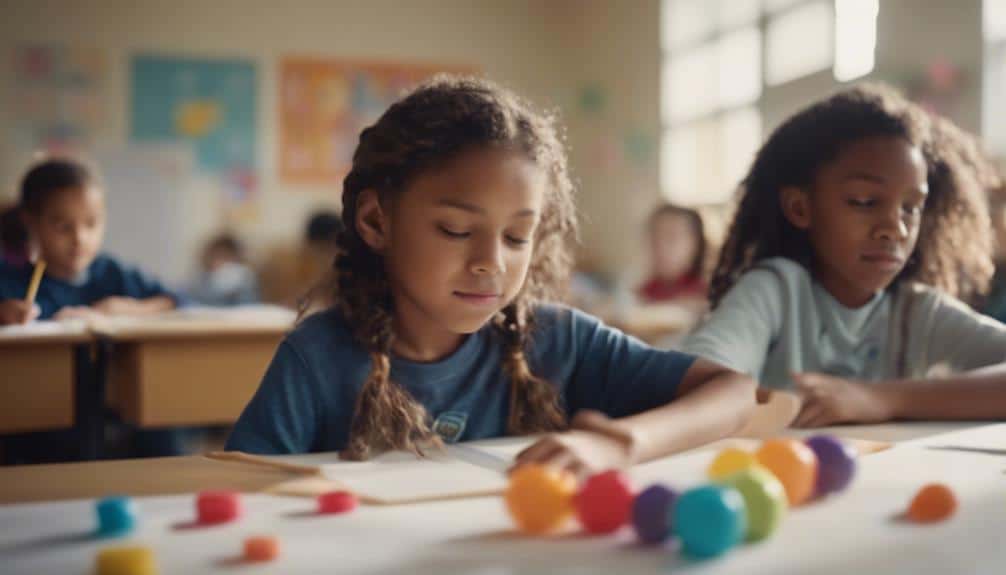As professionals in education and therapy, we acknowledge the multifaceted challenges students face in achieving academic success. Pediatric Occupational Therapy (OT) emerges as a pivotal support system, addressing the physical, cognitive, and sensory barriers hindering a child’s learning process. By tailoring interventions to enhance fine motor skills, sensory processing, and mental functions, pediatric OT practitioners play a critical role in paving the way for students to reach their full academic potential.
How exactly do these interventions translate into improved academic performance, and what evidence supports their efficacy? Let us explore the impact of Pediatric OT in fostering an environment conducive to learning and academic achievement.
Key Takeaways
- Pediatric OT enhances fine motor skills, improving handwriting and classroom task performance.
- Sensory processing interventions boost children’s ability to engage effectively in academic tasks.
- Strengthening visual skills supports reading, comprehension, and overall academic success.
- Fostering executive functions and emotional regulation leads to better organization, focus, and social interactions, boosting academic performance.
Understanding Pediatric OT
Pediatric OT Strategies for Academic Success plays a pivotal role in nurturing children’s cognitive, physical, sensory, and motor skills and lays the foundation for their academic and social success. This specialized pediatric therapy addresses various challenges that can hinder a child’s ability to perform daily activities effectively. By enhancing cognitive skills, OT helps improve attention, memory, and problem-solving abilities, which are crucial for learning and academic achievement.
Moreover, pediatric OT is instrumental in identifying and treating Sensory Processing Disorder (SPD) – a condition where the brain struggles to correctly process sensory information, leading to difficulties performing tasks requiring fine motor skills and coordination. Early intervention is a crucial aspect of pediatric OT, aiming to support children in reaching their developmental milestones, thereby maximizing their potential for academic success.
Occupational therapists employ a variety of strategies, including the use of play, to make therapy sessions engaging and effective. Through these tailored activities, children enhance their social, emotional, and physical skills, equipping them with the necessary tools to successfully navigate the challenges of academic environments.
Key Areas of Focus
Building on the foundational role of pediatric occupational therapy in enhancing children’s developmental skills, it is crucial to examine the specific areas of focus that directly contribute to academic success. Pediatric occupational therapy meticulously addresses critical aspects of a child’s development that are fundamental to their learning and performance in educational settings. These areas include but are not limited to developing fine motor skills, enhancing cognitive capabilities, and improving sensory processing abilities.
To effectively convey the breadth of these focus areas, consider the following table that outlines their significance, implications, and the targeted outcomes for academic success:
| Area of Focus | Significance | Targeted Outcomes for Academic Success |
|---|---|---|
| Fine Motor Skills | It is crucial for tasks like handwriting and drawing. | It improved my writing and drawing abilities. |
| Cognitive Skills | Encompass memory, problem-solving, organizational, and time management skills. | It has enhanced learning and problem-solving. |
| Sensory Processing | Addresses issues to improve focus and attention in academic settings. | Better focus and attention in class. |
Through these targeted interventions, pediatric occupational therapy plays a pivotal role in paving the way for a child’s academic success, ensuring they have the necessary skills to thrive in an educational environment.
Enhancing Fine Motor Skills

Enhancing fine motor skills is critical in ensuring children can effectively engage in essential academic activities such as writing and drawing. Occupational therapy plays a pivotal role in this process by focusing on developing hand strength, agility, coordination, and precise finger movements. These elements are foundational to improving a child’s ability to perform tasks that require fine motor skills, directly impacting their academic success through improved handwriting legibility, drawing abilities, and the efficient manipulation of small objects.
To effectively enhance fine motor skills, consider the following strategies:
- Targeted Exercises: Occupational therapy can introduce specific exercises to strengthen hand muscles and improve grip and finger control.
- Task-Specific Activities: Engaging children in activities that mimic academic tasks can help bridge the gap between therapy and classroom performance.
- Sensory Integration Techniques: These can enhance hand-eye coordination and fine motor planning, crucial for precision tasks.
- Adaptive Tools and Techniques: Introducing ergonomic writing instruments or modified grips can improve handwriting legibility and comfort, setting the stage for long-term academic success.
Boosting Handwriting Abilities
Building upon the foundation of enhancing fine motor skills, we now focus on boosting handwriting abilities, a pivotal area in pediatric occupational therapy for academic success. By employing various handwriting tools and techniques, occupational therapists can create individualized interventions that significantly improve the legibility and speed of a child’s writing. This tailored approach addresses each child’s unique challenges and empowers them to overcome obstacles to their academic achievements.
Fine Motor Skill Development
Improving fine motor skills through pediatric occupational therapy is pivotal for children’s handwriting development, directly impacting their academic achievements and confidence in school activities. Occupational Therapy (OT) offers a specialized approach that focuses on:
- Enhancing fine motor control is necessary for writing precision.
- Developing grip strength for better pencil control.
- Improving hand-eye coordination to support smooth and legible handwriting.
- Tailoring therapeutic exercises that increase dexterity for writing tasks.
Handwriting Tools & Techniques
After exploring the foundational role of fine motor skills in handwriting, it becomes essential to examine the specific tools and techniques that further boost handwriting abilities in children. Pediatric occupational Therapy (OT) is crucial in this process, providing personalized interventions that leverage handwriting tools such as pencil grips, slant boards, and raised-line paper to improve legibility. Techniques, including hand strengthening exercises and pencil grasp training, are imperative for speed and accuracy.
Moreover, weighted pencils or pens offer valuable sensory feedback, aiding in control for those facing handwriting difficulties. Visual aids like highlighted paper facilitate neat letter formation and spacing, while adaptive technology supports children with significant challenges. These OT strategies are instrumental in enabling children to overcome handwriting obstacles and fostering academic success.
Improving Sensory Processing

To address sensory processing challenges in children, occupational therapy employs various techniques and interventions designed to enhance their ability to interpret and respond to sensory stimuli effectively. Occupational therapists understand that sensory processing is foundational for children to engage successfully in daily activities, including academic tasks. When sensory processing is optimized, children can better regulate their responses to the environment, which, in turn, positively affects their academic performance and behavior.
Occupational therapy interventions for improving sensory processing in children might include:
- Sensory Integration Therapy: Activities that help the child’s brain integrate sensory information more effectively, enhancing their ability to participate in learning and social situations.
- Environmental Modifications: Adjusting the child’s surroundings to reduce sensory overload, such as dimming lights or reducing background noise, can help improve focus and academic engagement.
- Sensory Diets: Tailored daily activities that provide necessary sensory input to help the child maintain optimal arousal and focus.
- Therapeutic Exercises: Designed to strengthen the child’s ability to process and respond to sensory information, such as balance and coordination activities.
Strengthening Visual Perception
As we focus on strengthening visual perception within pediatric occupational therapy, it’s essential to recognize its foundational role in academic achievements. Enhancing reading skills, improving hand-eye coordination, and boosting puzzle-solving abilities are core components that significantly contribute to a child’s ability to process and interpret visual information effectively. These targeted interventions support the development of essential academic skills and encourage a more confident and engaged learner.
Enhancing Reading Skills
Enhancing reading skills through the strengthening of visual perception is vital to children’s academic success, focusing on developing their ability to recognize and interpret visual information efficiently. Occupational therapy plays a pivotal role in this area by employing:
- Visual tracking exercises to improve eye movements are essential for reading.
- Visual discrimination tasks that aid in letter recognition and word decoding.
- Interventions that enhance visual memory are crucial for comprehension.
- Techniques that increase visual processing speed, facilitating better reading performance.
Improving Hand-Eye Coordination
Improving hand-eye coordination is a foundational element in pediatric occupational therapy, designed to significantly bolster a child’s ability to perform academically by refining their visual perception skills. Through engaging activities like catching balls, threading beads, and playing target games, pediatric OT interventions meticulously aim to enhance hand-eye coordination. This skill is pivotal for handwriting, drawing, effectively using tools in academic tasks, and boosting visual-motor integration.
This integration is essential, as it helps children synchronize their hand movements with what they see, thereby improving tasks such as reading, copying from the board, and following classroom instructions. Strengthening visual perception through these targeted interventions leads to enhanced academic performance and overall learning outcomes, demonstrating the profound impact of pediatric occupational therapy in fostering academic success.
Boosting Puzzle-Solving Abilities
Pediatric occupational therapy is pivotal in sharpening children’s visual perception, a crucial skill set for mastering the intricacies of puzzle-solving and advancing their academic journey. Enhancing these skills through targeted interventions supports academic success and fosters children’s independence and confidence. Key areas of focus include:
- I recognize that shapes, patterns, and details in puzzles are foundational to developing problem-solving abilities.
- They enhance spatial awareness, enabling children to understand and navigate their physical and academic environments more effectively.
- Improving visual discrimination is critical for distinguishing between similar-looking objects or patterns.
- Developing visual processing skills is essential for solving complex puzzles and efficiently comprehending visual information.
Through these pediatric OT interventions, children learn to analyze and interpret visual stimuli more effectively, boosting their puzzle-solving capabilities and overall academic performance.
Developing Executive Functions
Fostering the development of executive functions in children is a critical step toward ensuring their academic success and behavioral improvement in school settings. Executive functions, including skills like planning, organization, time management, and self-control, are crucial for navigating the challenges of academic environments. Children with well-developed executive functions are likelier to exhibit improved academic performance and behavior in school. Occupational therapy interventions play a significant role in supporting the enhancement of these vital skills.
| Strategy | Description |
|---|---|
| Visual Schedules | Use visual aids to help children understand the sequence of activities and manage their time effectively. |
| Task Breakdowns | Break complex tasks into smaller, manageable steps to improve organizational skills and task completion. |
| Goal Setting | Teach children to set realistic goals and develop plans to achieve them, enhancing planning and self-monitoring skills. |
Implementing these strategies not only aids in developing executive functions but also empowers children to stay focused, complete assignments, and achieve their academic goals. Occupational therapists have the knowledge and tools to design interventions tailored to each child’s needs, ensuring they receive the support necessary to flourish academically and beyond.
Encouraging Play-Based Learning
Integrating play-based learning into pediatric occupational therapy offers a dynamic approach to cultivating essential academic and social skills in children. This methodology aligns with children’s natural inclinations to learn through play, significantly enhancing their cognitive development and educational achievements. By harnessing the power of play-based interventions, therapists can create a rich learning environment that is stimulating and nurturing.
The benefits of incorporating play into pediatric occupational therapy sessions include:
- Enhanced Cognitive Abilities: Play-based learning encourages children to think critically, solve problems creatively, and adapt to new challenges.
- Improved Academic Skills: Activities are designed to directly support the learning of math, literacy, and other academic content engagingly and memorably.
- Social and Language Development: Through play, children learn to communicate, cooperate, and engage with peers, fostering essential social skills.
- Motivation and Enjoyment: Play makes learning fun, increasing children’s motivation to participate and boosting their confidence in their abilities.
Research underscores the effectiveness of play-based learning in promoting academic success, making it a cornerstone of pediatric occupational therapy. By focusing on play, therapists can help children build a solid foundation for lifelong learning, ensuring they are both happy and academically successful.
Supporting Emotional Regulation
Occupational therapy is crucial in equipping children with effective coping strategies for emotional regulation, foundational for their academic and social success. By enhancing social interaction skills, occupational therapists support children in managing their emotions effectively, a key element in navigating the challenges of educational settings. These strategies not only help children deal with anxiety and frustration but also foster an environment conducive to learning and growth.
| Strategy | Impact |
|---|---|
| Mindfulness | It improves focus and reduces anxiety, enhancing academic performance. |
| Emotional Literacy | Enables understanding and expression of emotions, supporting social interactions. |
| Problem-solving Skills | Encourages resilience and adaptability, which are crucial for overcoming academic challenges. |
Occupational therapy’s approach to emotional regulation is comprehensive, aiming to enhance overall academic success by developing coping strategies. By encouraging positive social connections, occupational therapy lays a robust foundation for emotional well-being, supporting a thriving academic journey. This empathetic and knowledgeable guidance ensures that children are not only prepared to face academic pressures but are also equipped to navigate the complexities of social interactions, setting the stage for a well-rounded development.
Promoting Social Skills

Pediatric occupational therapy effectively utilizes structured social interactions and group activities to enhance children’s social skills, a cornerstone for academic and personal success. Through these interactive sessions, children learn to navigate the complexities of social interactions, which is vital for building meaningful relationships and succeeding in group settings, both academically and personally.
Critical elements of promoting social skills in pediatric occupational therapy include:
- Engaging in Cooperative Play: This allows children to learn the value of working together, sharing, and taking turns, which are essential components of teamwork and collaboration.
- Participating in Team-Based Tasks: Through these tasks, children develop communication skills and learn how to contribute effectively to a group goal, enhancing their collaborative abilities.
- Role-Playing Scenarios and Social Stories: These methods help children understand and interpret social cues, fostering empathy and improving their ability to interact appropriately in various social situations.
- Interactive Games and Activities: Designed to encourage social engagement, these activities provide a fun and safe environment for children to practice social skills and form positive peer relationships.
Integrating OT Strategies at Home
Integrating occupational therapy (OT) strategies within the home setting is a pivotal step toward reinforcing the skills children acquire during their therapy sessions. By creating a sensory space, establishing daily routines, and encouraging fine motor activities, parents can significantly contribute to their child’s ongoing development and academic success. These strategies support skill enhancement and ensure the seamless integration of these skills into everyday tasks, fostering independence and confidence in children.
Creating a Sensory Space
To support children with sensory processing difficulties, creating a sensory space at home can be a cornerstone for incorporating occupational therapy (OT) strategies into daily life. This specialized area can significantly enhance a child’s ability to regulate sensory input, improving focus and behavior. Here are crucial elements to consider:
- Including calming items such as weighted blankets and calming lights fosters relaxation.
- Selection of engaging fidget toys that support focus and stress reduction.
- Implementation of sensory activities that enhance self-regulation skills.
- Designing for safety and comfort, ensuring the sensory space is a secure environment for sensory play and exploration.
Establishing Daily Routines
Establishing consistent daily routines at home offers a foundational strategy for children to thrive academically by instilling a sense of structure and predictability. Integrating occupational therapy (OT) strategies into these routines enhances children’s organization, time management, and task completion skills, which are crucial for academic success. Visual schedules and checklists can foster independence and alleviate anxiety, making daily transitions smoother. Moreover, setting up designated study areas that consider ergonomics and incorporate sensory-friendly elements can significantly improve focus and productivity on academic tasks. Additionally, embedding regular breaks and sensory activities within these routines supports self-regulation and attention span, essential skills for effective learning. By adopting these practices, caregivers can create an environment conducive to academic achievement and holistic development.
Encouraging Fine Motor Activities
Encouraging fine motor activities at home, such as using playdough, beads, or puzzles, is pivotal in enhancing children’s hand strength, skill, and overall academic success. These activities improve physical skills and stimulate cognitive development, which is crucial for academic achievement. By integrating occupational therapy (OT) strategies into daily routines, parents and caregivers can significantly contribute to a child’s motor development and enhance their ability to perform tasks requiring fine motor skills, such as writing and drawing.
- I am cutting with scissors to develop hand-eye coordination and precision.
- We are threading beads to enhance skill and patience.
- They are manipulating playdough to strengthen hand muscles.
- I am completing puzzles to improve my problem-solving skills and finger agility.
Each activity supports the intricate connection between physical development and academic performance, fostering a holistic approach to learning and growth.
Frequently Asked Questions
How Do Pediatric OT Strategies for Academic Success Student’s Performance in Education?
Occupational therapists enhance students’ educational performance by addressing fine motor skills, sensory processing, and organizational abilities. They also focus on developing self-regulation and social skills and utilizing assistive technology to improve learning outcomes.
Why Is Pediatric OT Important?
Pediatric Occupational Therapy (OT) addresses developmental challenges and ensures children reach their full potential. It uniquely combines expertise, empathy, and tailored strategies to support holistic growth, which is crucial for a child’s successful educational journey.
What Are the Top 3 Qualities You Think a School OT Needs to Have to Be Successful, and Why?
To be successful, a school-based OT must possess strong communication skills for effective collaboration, adaptability to meet diverse student needs, and problem-solving abilities to identify and overcome barriers to academic success.
What Are the Goals of Pediatric Ot?
The primary goals of pediatric occupational therapy are to enhance fine motor, cognitive, and self-regulation skills, improve social interactions, and provide assistive technology to support children’s overall development and academic performance.
Conclusion
Occupational therapy practitioners play a significant role in promoting children’s health and participation in daily activities. Evidence shows that occupational therapy interventions can help children improve their perceptual skills, attention to task, and self-regulation skills, especially in youth ages and those with developmental delays, autism spectrum disorder, and attention deficit hyperactivity disorder.
The strength of evidence supports the effectiveness of sensory strategies, Ayres Sensory Integration, and self-regulation strategies in helping children with sensory processing disorders and emotional regulation challenges. Occupational therapy services in the school setting can also contribute to mental health promotion and successful participation in academic and functional tasks.
Occupational therapy assistants, guidance counselors, and pediatric occupational therapists can collaborate to provide activity-based interventions, behavioral approaches, and creative activities that cater to the child’s strengths and interests. Moderate evidence supports using cognitive approaches and positive reinforcement to improve participation in school and functional skills.
The holistic approach of occupational therapy practice can integrate motor activities, flexible seating, and sensory diet to control arousal levels, support literacy participation, and enhance academic participation. Visual closure, classroom rules, and art therapy can also aid children with handwriting difficulties and sensory processing disorders.
In conclusion, occupational therapy practitioners with evidence-based interventions and a functional focus can improve children’s participation in daily living and school activities, especially for 2nd graders, 9th graders, and those with mental health issues and differences.


Recent Comments